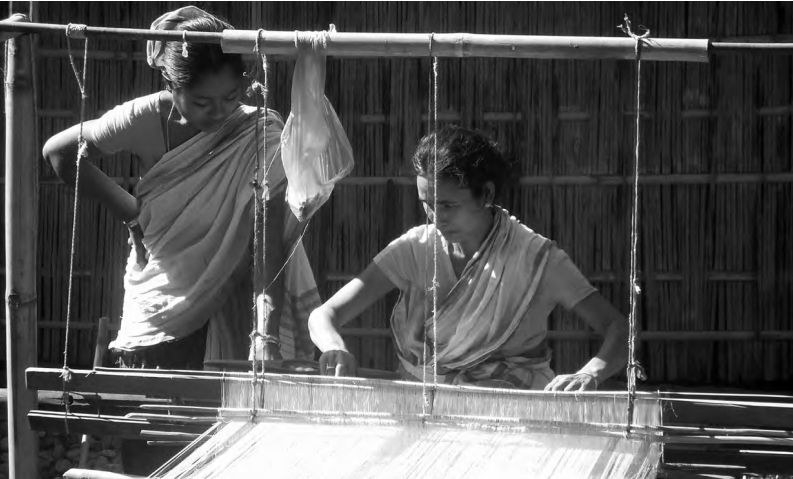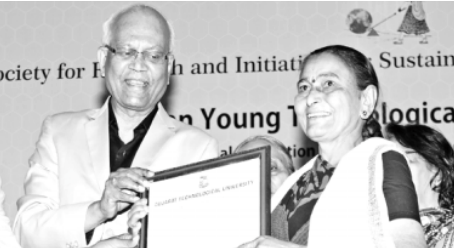“When Autumn Stanley spent 13 years studying and analysing the 200 year long history of patents in the USA to identify the contributions of women, she provoked a question that made her work among the least cited contribution. The biases against women’s knowledge are far deeper than is apparent in her study. She found that the share of the women inventors was hardly two percent in the 80s increasing to eight percent in the 90s.
In many cases, women had deferred to their husbands when taking credit. The situation in the Honey Bee database is similarly alarming. Despite the pioneering contribution of Gangaben in 1898, institutions have felt handicapped in harnessing the creative contributions of women. The examples here show how much one can learn if only one tries”
WOMEN, WISDOM AND WELL BEING
Arkhiben Mithabhai, Bamaniya village, Gujarat
Arkhiben was chosen as the community representative of SRISTI. Her expertise lies in keeping track of herbal formulations for pest control developed by people in her community, where she is regarded as a walking encyclopaedia. Her ideas lead to about 70-80 per cent success in pest control.
Along with her, many people in her community have developed herbal solutions for controlling pests in crops. Their individual practices have been pooled together to develop SRISTI drop which is more efficient than individual practices. It is being promoted by SRISTI Innovations, and the benefits are being shared with the communities. Learn more (Vol 22 – 4, Oct 2011 & March 2012)

Kapuriben Sardarsingh Baraiya, Dahod, Gujarat
Kapuriben has developed expertise in providing herbal medications. Along with her husband, she developed a herbal practice to prevent and cure bloat in animals. Bloat is a medical condition in which the stomach becomes overstretched by excessive gas content.
It is a serious medical condition and results in mortality if not treated properly. NIF facilitated the validation of the practice at Bombay Veterinary College, where the dosage standardisation was also carried out. Subsequently, a product was developed under the brand name Blotomin.
Santosh Pachar – Sikar, Rajasthan
Improved variety of carrot (Laxmangarh selection)
Santosh Pachar is an innovative farmer and grows various crops like vegetables and wheat. Few years ago, Santosh had collected some carrots for household consumption which had some unique characteristics. They variety of the carrot has a long root-length, sweetness, “Sinduri” (vermilion) color and softness.
So, she adopted the root-to-seed method of planting to produce seeds of this carrot. She collected the seeds of this carrot. She collected the seeds from the first-year plants and sowed them again in a small field and repeated the same method continuously for 4 to 5 years, which stabilised the desirable characters. She also used neem oil for controlling pest and disease. Learn more (Vol 23-4- Oct 2012 & March 2013)

Maltiben Joitaram Chowdhary – Gandhinagar, Gujarat
Maltiben has developed new techniques for the formulation of fodder. The innovator had also formulated many treatments for cattle as mentioned below :
1 – Dislocation of uterus
Three months prior to delivery of the animal, a pit of nearly 2 feet depth is dug at the place where the animal is kept. The pit is dug in such a way that the two front legs of the animal are directed into the pit. The animal is then made to stand near the pit in such a way that the forelegs are in the pit, and the posterior of the animal is elevated.
2 – Non-expulsion of placenta from the animal
If the placenta does not come out in the usual time, then around 4 to 5 kg of bajra (Pennisetum glaucum (L.) R.Br) grains are boiled along with 100g of ajma and 100g of suvadana (Anethum graveolens) and fed to the animal. Learn more
Lassiben Somabhai Parmar – Churu, Rajasthan
Lassiben serves as a repository of various herbal healing practices. A chilli crop grown by her is not only healthier, more productive but also disease free due to goat’s milk sprinkled with the help of neem twigs at an early stage to control leaf curl. She also uses a decoction of majeth (Rubia cordifolia L.) for pest control. By mixing the buttermilk and bitter cucumber in a copper vessel, she prepares a herbal pesticide for brinjal and chilli crops. She soaks kothamdra (bitter cucumber) in water for four days and then adds buttermilk to it.
She uses this formulation for curing leaf curl in the crops.
For problems like vomiting and worms in the stomach, in case of both animals and humans, she uses the leaves of seetafal (Annona squamosa L.) A handful of the leaves is fed as such or ground to a paste and then administered orally for two or three days. For treating diarrhoea, she encourages the use of seeds of khakhra (Butea monosperma (Lam.) Taub). Learn more (Vol 21-2 April-June 2010)
Gulabben Chauhan Abhay Singh – Vadodara, Gujarat
She is the most senior woman farmer with indigenous knowledge about eco indications. Gulabben never went to school but she has plenty of expertise in eco indications. In 1994-95, she gave us a lot of information in eco-indication practices.
1 – When taankaniya (a bird like a dove) is sighted it is an indication of rain
2 – An insect named vaniya (insect) if it is seen in the field, or if a spider’s web is found in a bullock’s foot impression, then there would be no rains and most probably there would be a drought.
3 – When the sun is about to set and if we can still see our shadow, there would be heavy and rapid rainfall in 1 or 2 days, even if no black clouds are seen in the sky. Learn more
Janaki Devi – Paschimi Champaran, Bihar
Janki Devi has developed herbal formulation to control whiteflies in different crops using two local herbs. Laboratory trials, conducted by Sadbhav SRISTI Sanshodhan Lab, Ahmedabad, have demonstrated that the formulation induced significant mortality within a short time application in nymphs.
In addiction, it appeared to be particularly effective against late instars and at the pupa stage.
The preliminary trials also demonstrated that it could significantly reduce pest infestations over an extended period and that it performed better than other available products. Repellence increased with the increase in concentration of the formulation. A patent (1699/KOL/2008) has been filed in her name. Learn more (Vol 20-4 & 21-1 Oct-March 2010)
Kunwarben Hirabai Parmar – Chandrala village, Patan Dist, Gujarat
Expertise in helping in child delivery
Kunwarben was born into a family of cobblers. She started helping women in the child birth process when she was very young. She has helped the last four generations of women to deliver their children, almost 1200 childbirths, and even at the age of 80 she is still active in helping women with delivery.
She is an expert in complicated delivery cases, where even the doctors give up.
She uses her indigenous knowledge and solves such cases very easily. For example, in one case the new born wasn’t breathing at all, so the family members started crying but she consoled them saying that the new born is not dead. She asked the family members to bring a stove and a flat vessel, wherein she heated the flat vessel on the stove and she placed the umbilical cord on the vessel, due to the heat the baby started crying. Learn more
Kantaben Govindbhai Patel – Kheda village, Kheda village, Jakhala Dist, Gujarat
She is recipe expert. When she was a young girl, she learned from her mother and grandmother how to cook repices from uncultivated plants. Later on, when she was married, she learned more such recipes from her mother-in-law. Soon she was experimenting on her own and made new nutritious dishes. She learnt some recipes from her mother and grandmother such as of cluster beans and guar ki patti.
She can create a vegetable dish from very tender and soft guar leaves.
She learnt arni ki bhaaji (Clerodendrum reticulata) and make a recipe from drumstick leaves. She also makes a juice by mixing mint, ginger, mango, jaggery and basil, during the summer. This juice is good for immunity, dehydration and also re-energises the body. Learn more (Vol 14-1-Jan-Mar 2003)
“Why do girl children score well in the idea competition among children but voice of women gets muted while searching for grassroots innovators?”
Remya Jose – Kerala
Remya Jose, at the age of 16 years thought of an innovation where she can do exercise and wash clothes simultaneously.
Learn more (Vol 16-3 Jul-Sep 2005)

Jamnaben Patel – Chikli, Navsari Dist, Gujarat
Jamnaben Somabhai Damor is considered to be a specialist when it comes to treating animals in and around Timla village, district Panchmahal of Gujarat. She had learnt the secrets of all the healing herbs by watching her mother and grandmother at work. she had in her an innate urge to unravel the secret potential of medicinal plants.
She has not only tried the proven traditional remedies, but has also experimented with some modifications thus learning the practical applications of each of them. Learn more (Vol 11-1-Jan-March 2000)
WOMEN AS TEACHERS
Priti Gandhi – Kalol, Gujarat
Priti developed the concept of the little library and reading rooms in the corner of schools. She suggested the school to purchase a list of books across different levels and genres. The process suggested by her was :
1 – Divide books into sets of 25, consisting of different levels and genres.
2 – Procure small aluminium boxes that can house up to 25 books
3 – Keep a set of 25 books in each aluminium box. Learn more (Vol 24-3 Jul-Sep 2013)

